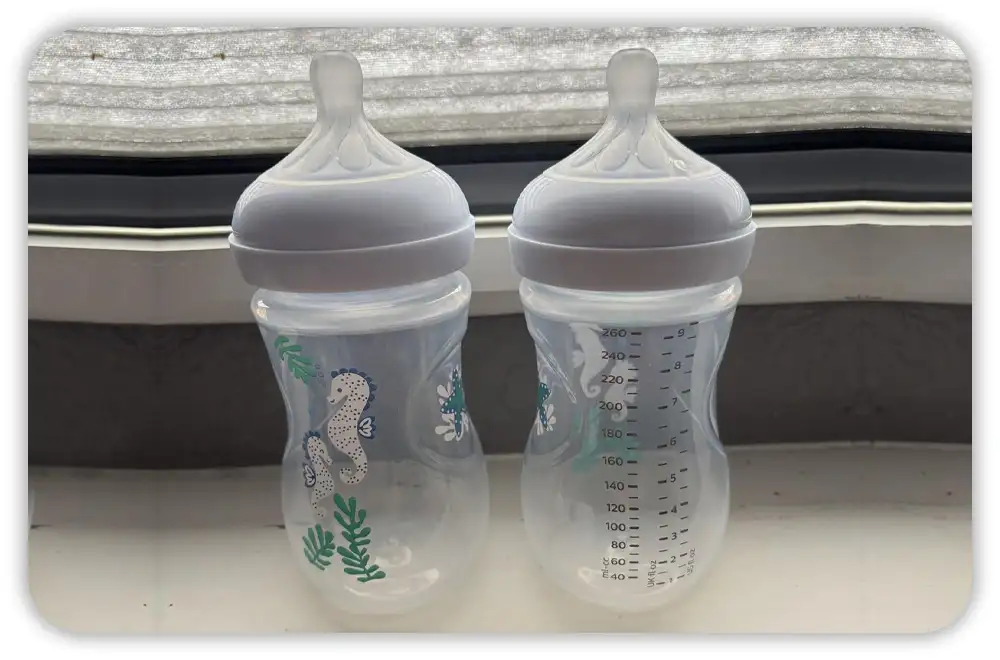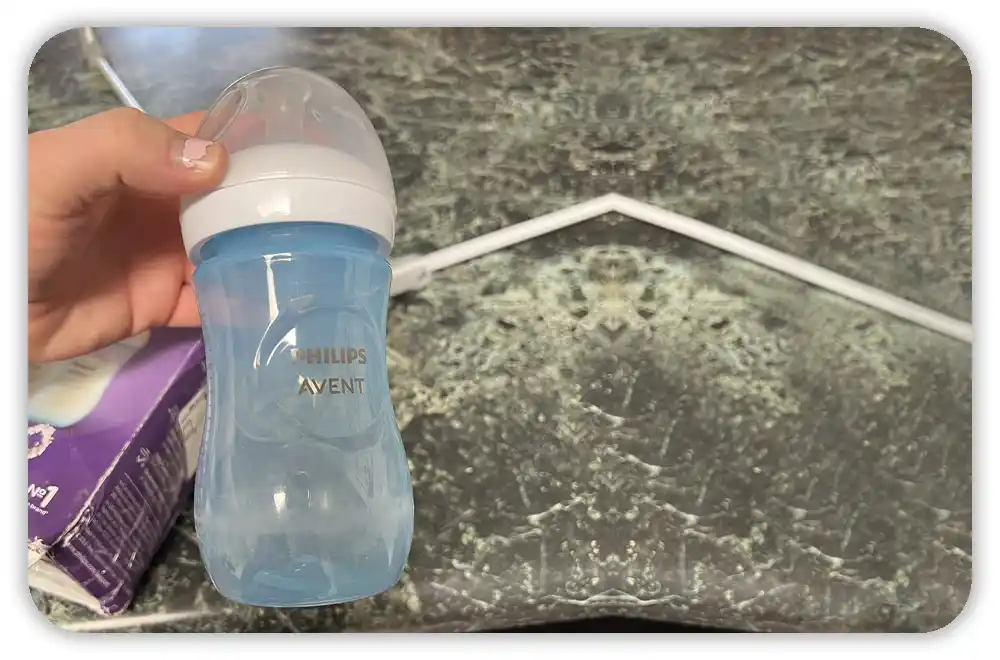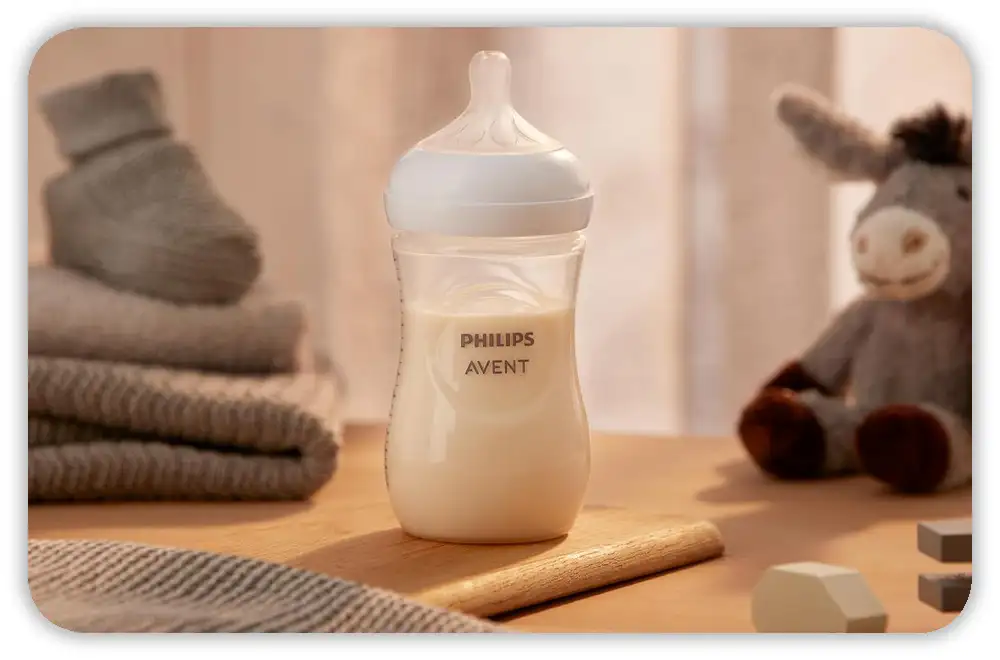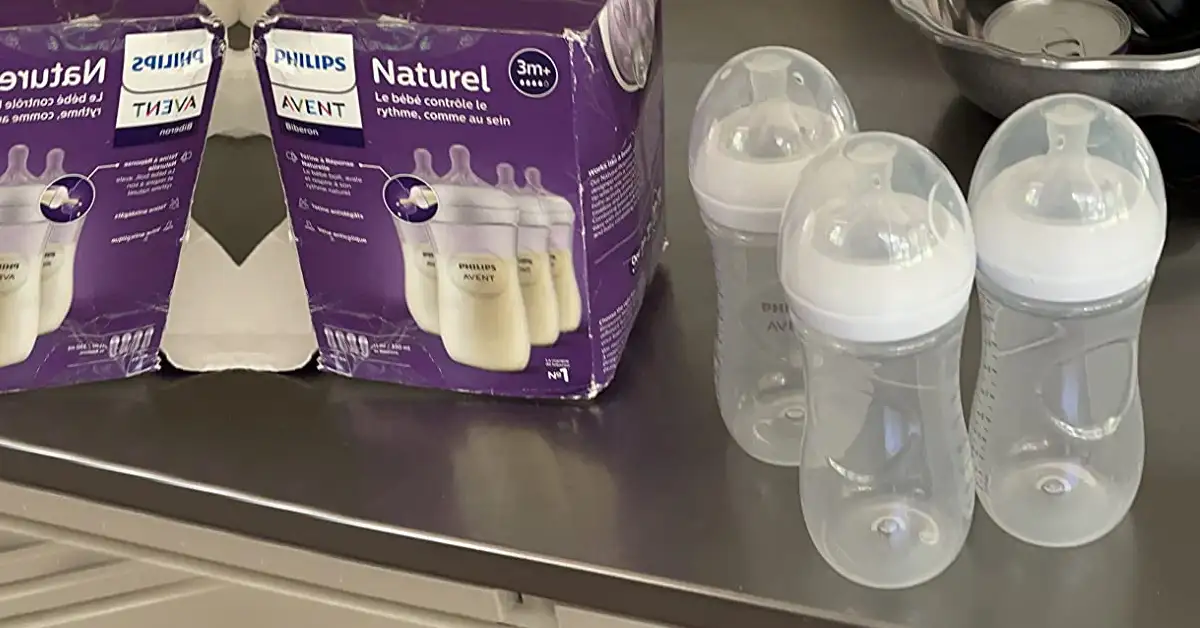I remember standing at the sink one night, half-asleep, staring at a pile of bottles. I thought, “Can I just toss these in the dishwasher and be done?”
The short answer: yes. But there are a few rules that can mean the difference between bottles that last and ones that warp, cloud, or wear out fast.
After three kids and more dishwasher loads than I can count, I’ve learned a lot. I know what works, what ruins a bottle in weeks, and the small habits that keep them safe for months.
This guide will show you what’s safe, what’s not, and how to make your Philips Avent bottles last well past the newborn stage.
Table of Contents
Quick Answer: Can Philips Avent Baby Bottles Go in the Dishwasher?
Yes — most Philips Avent baby bottles are dishwasher safe. The key is loading them the right way so they last. Always place them on the top rack, where the heat is softer. This helps prevent warping, cloudiness, and early wear.
Material plays a big role. Plastic Avent bottles are made from BPA-free polypropylene. They’re light and easy to handle but can turn cloudy faster if exposed to too much heat. Glass Avent bottles are made from borosilicate glass. They handle high heat better and stay clear longer, though they’re heavier and can chip if placed carelessly.
Philips Avent’s own advice matches my experience as a parent: take all parts apart, rinse them first, and keep everything on the top rack. If you care for them this way, they can last well past those long newborn months.
Understanding Philips Avent Bottle Types
Not all Avent bottles are the same, and that affects how you clean them.

Plastic Bottles
- Made from BPA-free polypropylene (PP)
- Light and easy to hold — great for quick feeds
- Can get cloudy or scratched with frequent dishwasher use
- Best for parents who want something light and less breakable
Glass Bottles
- Made from borosilicate glass — very heat-resistant
- Stay clear and odor-free even with daily dishwasher cycles
- Heavier and less forgiving if dropped
- Great for long-term use and eco-conscious parents
Why it matters: Pick the right material so you know what to expect. Plastic may need more gentle care. Glass can handle the heat — literally.
Which Philips Avent Parts Are Dishwasher Safe (and Which Are Not)
| Part | Dishwasher Safe? | Placement Tip |
| Bottle (Plastic) | Yes | Top rack only |
| Bottle (Glass) | Yes | Top rack or lower rack with extra protection |
| Nipple (Silicone) | Yes | Use a small parts basket, top rack only |
| Screw Ring | Yes | Top rack |
| Cap/Cover | Yes | Top rack |
| Anti-Colic Vent System | Yes | Basket or mesh bag to keep from getting lost |
How to Safely Clean Philips Avent Bottles in the Dishwasher

Over the years, I’ve found that how you load the dishwasher makes a big difference. It can mean the difference between bottles that last and bottles that look worn after a month. Here’s my routine:
- Take everything apart — every ring, vent, and tiny piece. If you skip this, water and milk can hide in small spaces.
- Rinse right after use — even a quick swirl under the tap helps. Dried milk is hard to remove and can leave a film.
- Use a small parts basket for nipples and vents. I learned this after a nipple went on a “dishwasher vacation” to the bottom of the machine.
- Place on the top rack — the heat and spray are softer there.
- Skip heated dry — high heat can shorten the life of silicone parts.
- Air-dry on a clean rack or mat — this keeps parts fresh and odor-free.
When & How to Sanitize Philips Avent Bottles
Daily washing is enough for most healthy babies. But if your baby is under 3 months, born premature, or has a weaker immune system, the CDC says to sanitize too. I followed this during my first months with each baby.
Ways to sanitize:
- Dishwasher sanitize cycle — Use only for dishwasher-safe parts. It uses higher heat to kill more germs.
- Boiling method — Boil a pot of water. Drop in clean bottle parts for 5 minutes. Remove carefully and air-dry.
- Microwave steam sterilizer or bags — Good for quick sanitizing without running the full dishwasher.
- Philips Avent electric steam sterilizer — Works well if you have many bottles to clean at once.
My routine: sanitize once a day when my babies were tiny. Then I switched to every few days as they grew.
Pros and Cons of Using the Dishwasher for Baby Bottles
If you’re wondering whether the dishwasher is worth it, here’s my honest view after years of doing both.

Pros
- Saves time — no standing at the sink after each feed
- Consistent cleaning — especially with a sanitize cycle
- Great for bulk loads — perfect if you use many bottles daily
Cons
- Wear on nipples — silicone can lose shape faster
- Plastic clouding — heat and detergent can age bottles
- Small parts risk — nipples and vents can slip through racks if not contained
In my home, I mix methods. The dishwasher handles bottles and hard parts. I handwash delicate pieces like nipples. This keeps everything cleaner for longer — and keeps me sane.
Common Mistakes to Avoid
Even if bottles are “dishwasher safe,” a few small mistakes can cause big problems. I’ve made them all:
- Mixing up top/bottom rack placement — The bottom rack gets the hottest spray. That’s fine for glass but tough on plastic and silicone.
- Using harsh or scented detergents — They can leave a soapy taste or smell. Stick to mild, fragrance-free soap.
- Not taking apart the anti-colic system — Tiny vents can trap milk, which can turn into mold.
- Leaving bottles damp in closed containers — This invites bacteria. Always air-dry fully before storing.
I’ve learned it’s faster to do it right once than to rewash later.
Philips Avent’s Official Guidelines
Philips Avent’s manual is simple — and it matches what works best for me:
- Top rack only — every part, every time.
- Gentle cycle when possible — protects plastic and silicone.
- Rinse before loading — so milk doesn’t bake on during the cycle.
- Replace worn parts — Nipples can stretch, tear, or thin. If you see cracks or cloudiness, swap them out.
Their tips help keep bottles safe, clean, and long-lasting.
My Mom Experience With Cleaning Philips Avent Bottles
When my first baby was born, I put every part on the bottom rack. Two weeks later, nipples were warped, and one ring was bent so it wouldn’t seal. I didn’t know the dishwasher could do that.
By baby number three, I had a system:
- Dishwasher for bottles, rings, caps, and vent pieces.
- Handwash for nipples and softer parts.
- Quick rinse after each feed so nothing dried on.
This kept my bottles looking new for months — and feeding time stress-free.
Final Verdict: Are Philips Avent Baby Bottles Dishwasher Safe?
Yes — most Philips Avent bottles can go in the dishwasher. It’s a lifesaver for busy parents.
The key is top rack only, take every piece apart, and handwash delicate parts like nipples. Mixing methods works best: dishwasher for speed, handwashing for care. That way, you get both convenience and long life from your bottles.
FAQs: Are Philips Avent baby bottles dishwasher safe
Can Philips Avent nipples go in the dishwasher?
Yes. Place them in a small parts basket on the top rack. This stops heat damage and keeps them from getting lost.
Should I use the dishwasher’s sanitize cycle for Avent bottles?
Only for safe parts. The sanitize cycle uses high heat. This is fine for glass but can wear silicone nipples faster.
Do Philips Avent bottles get cloudy in the dishwasher?
Yes. Plastic bottles can turn cloudy from heat and soap. It looks different but is still safe to use.
Is handwashing better than using the dishwasher for Avent bottles?
Handwashing is softer on nipples and plastic parts. The dishwasher is faster for many bottles at once. Many parents do both.

